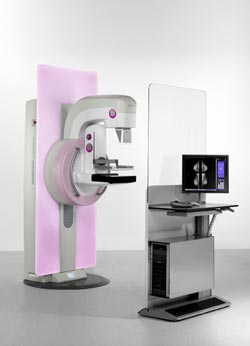New Siemens mammography system lowers radiation dose up to 30 percent

<br>
The Mammomat Inspiration Prime Edition lowers dose by replacing the standard scatter radiation grid with a new algorithm for progressive image reconstruction. This new algorithm identifies scatter-causing structures and calculates a corrected image, enabling complete use of primary radiation so physicians can achieve high-quality images with less dose. The development of innovative products like the digital full-field Mammomat Inspiration is a goal of the Siemens Healthcare Sector's global “Agenda 2013” initiative.
In digital X-ray breast imaging, radiation passes through the examined breast to a detector. Primary radiation supplies the information needed to produce the X-ray image, while scattered radiation is absorbed by special grids positioned between the breast and the detector. Unfortunately, these scatter grids also absorb part of the all-important primary radiation, forcing physicians to use a higher dose to obtain images of desired quality. Since mammography means regular screening of healthy women, minimizing dose is extremely important.
Siemens' new reconstruction algorithm for the Mammomat Inspiration system – known as Prime (Progressive Reconstruction, Intelligently Minimizing Exposure) – eliminates the need for the conventional scatter radiation grid. The Prime algorithm subsequently corrects the scattered radiation by identifying scatter-causing structures and recalculating the image. The primary radiation that radiologists rely upon remains intact. Therefore, a grid is no longer necessary, and lower doses are sufficient to produce high-quality images. The grid-free imaging technology of the Mammomat Inspiration Prime Edition can reduce radiation dose up to 30 percent compared to its predecessor model, depending on the thickness of the patient's breast tissue.
Shipping the first quarter of 2013, the Mammomat Inspiration Prime Edition is based on the modular Mammomat Inspiration platform for screening, diagnostics, biopsy, and tomosynthesis used by hospitals and physicians' offices since 2007. Facilities have the option of purchasing the basic equipment, upgrading biopsy or tomosynthesis later as the need arises.
The software-driven Mammomat Inspiration Prime Edition demonstrates the innovative power of Siemens Healthcare and meets a goal of the global “Agenda 2013” initiative, which the Siemens Healthcare Sector unveiled in November 2011. The initiative defines plans of action to be implemented within two years in the areas of innovation, competitiveness, regional presence, and human resource development.
The Siemens Healthcare Sector is one of the world's largest suppliers to the healthcare industry and a trendsetter in medical imaging, laboratory diagnostics, medical information technology and hearing aids. Siemens offers its customers products and solutions for the entire range of patient care from a single source – from prevention and early detection to diagnosis, and on to treatment and aftercare. By optimizing clinical workflows for the most common diseases, Siemens also makes healthcare faster, better and more cost-effective. Siemens Healthcare employs some 51,000 employees worldwide and operates around the world. In fiscal year 2012 (to September 30), the Sector posted revenue of 13.6 billion euros and profit of 1.8 billion euros. For further information please visit: http://www.siemens.com/healthcare
The products mentioned here are not commercially available in all countries. Due to regulatory reasons the future availability in any country cannot be guaranteed. Further details are available from the local Siemens organizations.
Tomosynthesis is not available in the U.S.
Reference Number: HCP201211004e
Contact
Ms. Kathrin Schmich
Healthcare Sector
Siemens AG
Henkestr. 127
91052 Erlangen
Germany
Tel: +49 (9131) 84-5337
kathrin.schmich@siemens.com
Media Contact
More Information:
http://www.siemens.com/healthcareAll latest news from the category: Medical Engineering
The development of medical equipment, products and technical procedures is characterized by high research and development costs in a variety of fields related to the study of human medicine.
innovations-report provides informative and stimulating reports and articles on topics ranging from imaging processes, cell and tissue techniques, optical techniques, implants, orthopedic aids, clinical and medical office equipment, dialysis systems and x-ray/radiation monitoring devices to endoscopy, ultrasound, surgical techniques, and dental materials.
Newest articles

High-energy-density aqueous battery based on halogen multi-electron transfer
Traditional non-aqueous lithium-ion batteries have a high energy density, but their safety is compromised due to the flammable organic electrolytes they utilize. Aqueous batteries use water as the solvent for…

First-ever combined heart pump and pig kidney transplant
…gives new hope to patient with terminal illness. Surgeons at NYU Langone Health performed the first-ever combined mechanical heart pump and gene-edited pig kidney transplant surgery in a 54-year-old woman…

Biophysics: Testing how well biomarkers work
LMU researchers have developed a method to determine how reliably target proteins can be labeled using super-resolution fluorescence microscopy. Modern microscopy techniques make it possible to examine the inner workings…





















